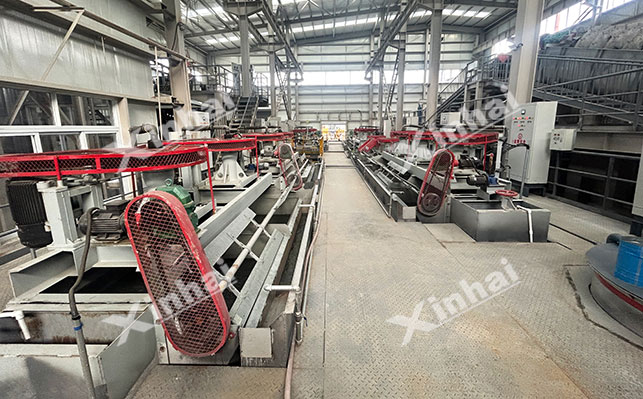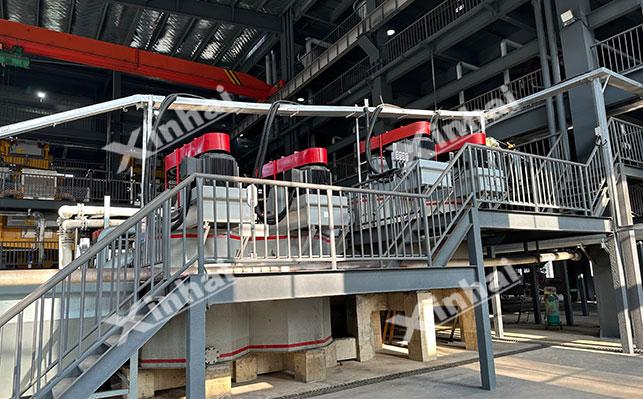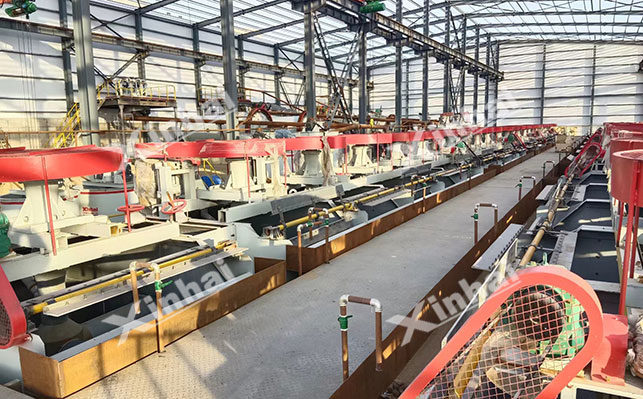
15311826613
Click to add WeChatRecently, tungsten prices have hit a ten-year high. The price of black tungsten concentrate has climbed to 184,000 yuan/ton, white tungsten concentrate to 183,000 yuan/ton, and tungsten powder to 400 yuan/kg. All prices have increased by over 25% since the beginning of the year. This phenomenon is driven by both supply and demand imbalances and a revaluation of the strategic resource's worth. Faced with challenges such as declining resource grades and tightening environmental policies, optimizing tungsten ore beneficiation processes is a core means for enterprises to reduce costs, increase efficiency, and enhance competitiveness. Meanwhile, the explosive growth in emerging demands from the military and new energy sectors further strengthens tungsten's strategic position. This article will focus on tungsten ore beneficiation technology and its optimization directions.
Wollastonite is mainly composed of ferromanganese ore, which has a high density and weak magnetic properties. Therefore, gravity separation is the primary beneficiation method, with combined magnetoelectric and flotation processes used as auxiliary technologies to recover the wolframite concentrate.

Jig Gravity Separation: This method primarily relies on the flow rates of the water generated by the equipment to achieve effective separation between minerals. Generally, wolframite, with its high density, will quickly descend to the screen plate, while gangue will flow out with the overflow. Jigging is mostly suitable for the separation of coarse-grained disseminated wolframite of 3-5mm.
Shaking table gravity separation: This method utilizes the reciprocating motion of water flow on an inclined plane and the table surface to force heavier coarse particles to fan out on the table surface, gradually enriching them. Shaking tables have high selectivity and are mainly used for separating medium and fine-grained minerals of 0.5-3mm.
Spiral concentrator: This method mainly utilizes the centrifugal force and gravity generated within the concentrator tank to force heavier wolframite to move along the inner side of the tank bottom to become concentrate, while gangue is discharged directly along the outer side, achieving separation. It is suitable for processing fine-grained minerals of -2mm.
Magnetoelectric combined method is mainly used for wolframite beneficiation containing magnetic impurities or exhibiting differences in conductivity, with the aim of improving concentrate purity.
Magnetic separation: Primarily employs strong magnetic separation, utilizing the weak magnetic properties of wolframite. It is adsorbed onto the surface of a magnetic roller in a non-uniform magnetic field, separating it from the non-magnetic gangue. This effectively removes most magnetic impurities, thereby improving the grade of wolframite concentrate.
Electrostatic separation: Employs high-voltage electrostatic separation, utilizing the difference in conductivity between wolframite and gangue. In a 40kV high-voltage electric field, wolframite is adsorbed by the electrodes and detaches to form a conductive product, mainly used for the deep purification of wolframite concentrate.

When the gravity separation tailings still contain 10%-15% fine-grained wolframite and intergrowths, flotation can be used for recovery. This relies on reagents to control surface hydrophobicity and involves roughing, cleaning, and scavenging processes. Roughing: Oleic acid and oxidized paraffin soap are used as collectors. The carboxyl groups react with Ca²⁺ on the surface of scheelite to form a hydrophobic film. Water glass is used to adsorb onto the gangue surface to form a hydrophilic silica film, which inhibits calcium-containing minerals such as fluorite and calcite. Sodium carbonate is used to adjust the pH to 9-10 to obtain a rough concentrate. Cleaning: After concentration, the rough concentrate enters the cleaning process. The amount of water glass is gradually increased, and a small amount of tannin is added to enhance the inhibition of carbonate gangue. "Heated cleaning" is used at the end of the cleaning process to obtain the final concentrate. Scavenging: The tailings from the roughing process undergo several scavenging processes, and a small amount of collector and frother is added to recover residual scheelite.
Scheelite has a low density and often occurs in association with calcium-bearing gangue such as fluorite and calcite. Its floatability is similar, therefore flotation is often the primary method used.

Ambient temperature flotation is carried out at room temperature (20-30℃). It utilizes fatty acid collectors to adsorb scheelite. By adjusting the pH of the pulp and using water glass as a depressant, the hydrophobicity of the scheelite surface is enhanced, while simultaneously inhibiting the flotation of gangue minerals, thus achieving separation. The process typically employs a roughing, cleaning, and scavenging process. Lead nitrate is added as an activator in the cleaning stage. Pb²⁺ reacts with WO₄²⁻ on the surface of scheelite to form an activation layer, enhancing its interaction with the collector. 2. High-Temperature Flotation Method for Scheelite The high-temperature method involves heating the slurry to 80-90℃, causing the fatty acid collectors adsorbed on the surfaces of fluorite and calcite to desorb, while the collector adsorption on the surface of scheelite is more stable. Sulfuric acid is used to adjust the pH to 6.5-7.5, and separation is achieved through multiple cleaning stages.
Mixed tungsten is a mixture of wolframite and scheelite. Due to the significant differences in properties between the two minerals, combined processes are often used in beneficiation to achieve synergistic recovery.
Preferential flotation typically involves selecting wolframite first, followed by scheelite.

Preferential flotation of wolframite: The pulp pH is adjusted to 6.5 with sulfuric acid, and benzohydroxyxamic acid + lead nitrate are added. The collector adsorbs wolframite, and the lead nitrate activates the wolframite surface, yielding a wolframite rough concentrate.
Subsequent flotation of scheelite: The tailings are adjusted to pH 9.5 with sodium carbonate, modified oleic acid is added to collect scheelite, and water glass is used to suppress gangue, yielding scheelite concentrate.
Iron tungsten beneficiation: The middlings are regrinded and re-concentrated separately to finally obtain both iron tungsten concentrate and scheelite concentrate.
The combined magnetic-flotation beneficiation process involves first grinding the raw ore to -0.074mm (70%), then using a high-gradient magnetic separator with a field strength of 1.6T to separate iron tungsten ore, yielding iron tungsten concentrate. The tailings are then subjected to high-temperature flotation to recover scheelite.
Today, with the increasing depletion and complexity of tungsten resources, beneficiation technology must continuously innovate to adapt to the properties of different types of ores. Xinhai, relying on its Mining Research Institute, Mining Design Institute, and Pilot Plant Center, can tailor-make design schemes for each mine. Based on mine test results and basic data, and adhering to the principles of production convenience, efficient management, production safety, and saving land and investment, it configures equipment and processes to provide professional and reliable solutions.
Xinhai's technical team can implement overall layout design, process flow design, equipment selection and layout, civil construction design, infrastructure design, safety and environmental protection design, and automation design. Design principles include optimizing production, management, safety, land use, and investment, providing professional and reliable solutions. In addition, we offer project planning approval, design renderings, and government drawing review services, and apply VR, AR, naked-eye 3D, and 720° panoramic technologies to the concentrator plant demonstration, facilitating automated and intelligent design.
Xinhai Mining Design Institute is equipped with SolidWorks 3D design software and a PDM design management system, enabling the design of conventional, mobile, 3D, and modular steel structure concentrator plants. Modular steel structure design reduces civil engineering workload, construction time, and investment, and facilitates disassembly and relocation.
Xinhai Mining Design Institute possesses international design capabilities and can conduct mine design according to the following standards:
Chinese Standards: Complies with domestic mine design specifications and requirements.
Australian JORC Standards: Follows Australian mineral resources and reserves reporting standards.
Valmin Specifications: Complies with Australian mine design and resource assessment specifications.
Canadian NI43-101 Standard: Meets Canadian requirements for mineral resource and reserve disclosure.
If you are experiencing difficulties with tungsten ore beneficiation due to a lack of solutions or unsatisfactory returns, please consult Xinhai Mining Equipment. We can provide beneficiation plant design and modification services.